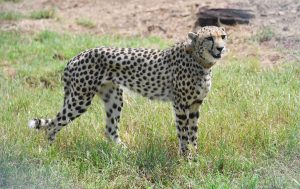
Why wildlife conservationist Ranjitsinh is all for cheetah’s ghar wapsi
Cheetahs survived in India till the 1950s; since then, climate and habitat variety have not undergone drastic changes, so the big cats will do well here, argues ace wildlife conservationist MK Ranjitsinh

As India celebrates the government’s ambitious cheetah reintroduction programme, conservationists have warned that the project is unlikely to succeed because India does not have the habitat or prey species for wild, free-roaming African cheetahs. They also feel it would have been better to prioritise the conservation of other threatened species.
In an exclusive interview with The Federal, ace wildlife conservationist MK Ranjitsinh, who has been instrumental in bringing the Namibian cheetah to India, helped decode the popular myth around India’s chances of succeeding in the cheetah translocation programme. He also spoke about what this means for the global conservation effort.
The top conservationist further reiterated that this is just the first step, and India has a long way to go before it can truly gauge the success of the project. Edited excerpts:
Also read: Cheetah: Faster than most cars but low on stamina, cannot protect its kill
Conservationists have said that India’s cheetah programme will not succeed due to inadequate habitat and prey base. What is your reading of it?

As far as the habitat is concerned, the cheetahs survived in India till the 1950s. Climate and habitat variety have not undergone drastic changes. The suitability of the habitat and availability of prey have been certified by the top cheetah experts in Africa and Namibia. The Wildlife Institute of India has also green-lighted the project. The questions on prey base and suitability of the habit are being raised by people with very little knowledge of the matter.
Do you think India will succeed in its stated aim of grassland conservation?
It is not only about grassland conservation. It is the grassland-forest mosaics which are among the most productive ecosystems. The plain grassland ecosystem has been downsized and the Great Indian Bustard has been occupying it. The cheetah needs the grassland-forest mosaics to thrive. The South African model is an apt example of it.
Also read: Illegal trade in exotic animals booms as Indian ‘pet lovers’ go wild
What went behind the selection of Kuno as the site?
It involved numerous surveys and then the Wildlife Institute of India gave its nod. It found Kuno National Park to be the most ideal site after pan India surveys. The reports were also presented in international forums, thereby giving greater credence to the survey.
The Supreme Court in 2013 expressed concern over the relocation project but gave its nod in 2020 on an experimental basis…
The Supreme Court wasn’t apprised of the correct report. Findings on the relocation attempt weren’t presented in totality. It was in 2020 that the SC appointed a committee to look into it. I was the chairman of the committee, and then we presented the correct reports before the court. Therefore it took a little longer for the project to fructify. The reports mentioned that Wildlife Board and IUCN guidelines were followed while framing the draft relocation papers.
Also read: Project Cheetah to do wonders for Rajasthan tourism, hope experts
India is looking at specific aims like reclaiming the cheetah’s functional role as the top predator, global conservation efforts and boosting domestic ecological initiatives. How far will this drive enable that?
It will give a huge boost to India’s conservation efforts, which have been restricted somewhat. India has a true penchant for symbolism. The Tiger Project was one such project that India managed successfully. We used the tiger as a mascot to save tiger habitats. So, in terms of conservation, it’s a great starting point. Cheetahs can be used as a flagship species to save their habitat and, in turn, reverse the ecological imbalances.
Wildlife biologist and conservation scientist Ravi Chellam’s argument that the cheetah translocation programme is to mask the issues of Asiatic lions has made some news. What do you think of it?
Why do we need to see both these – relocation of lions from Gir and cheetahs from Africa — separately? Can’t they coexist? It should be viewed in terms of the need of the hour and not just as an exercise.
Also read: Cheetahs: Their Mughal connection, and how they went extinct in India

